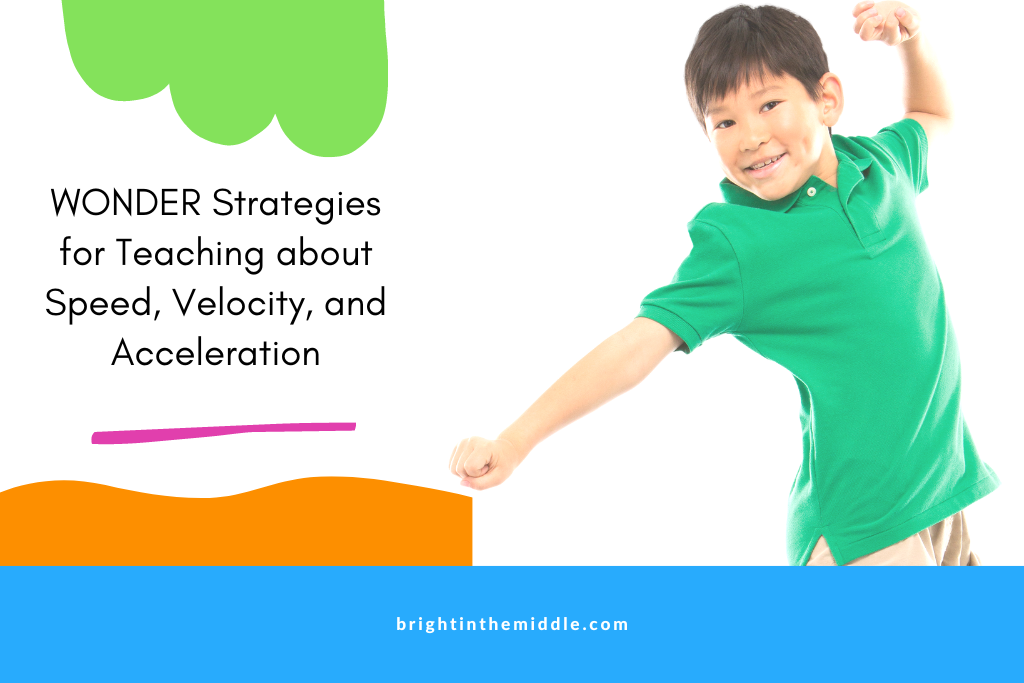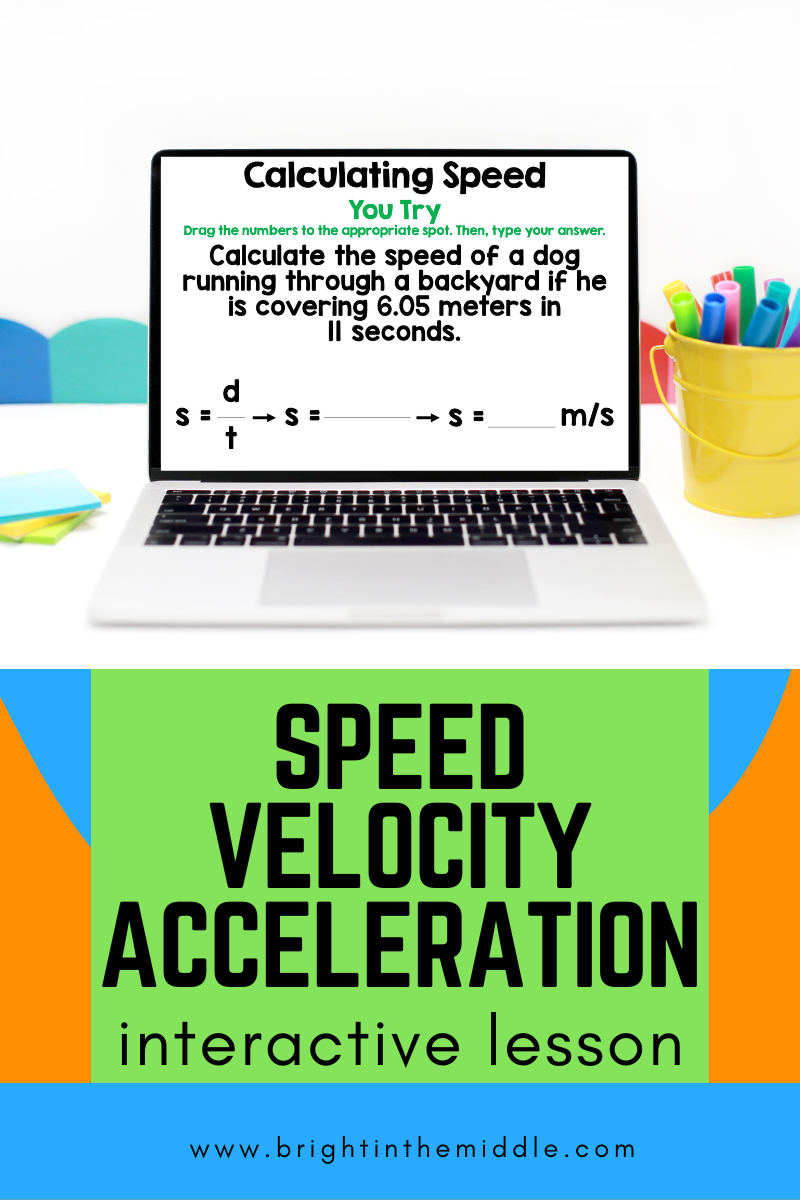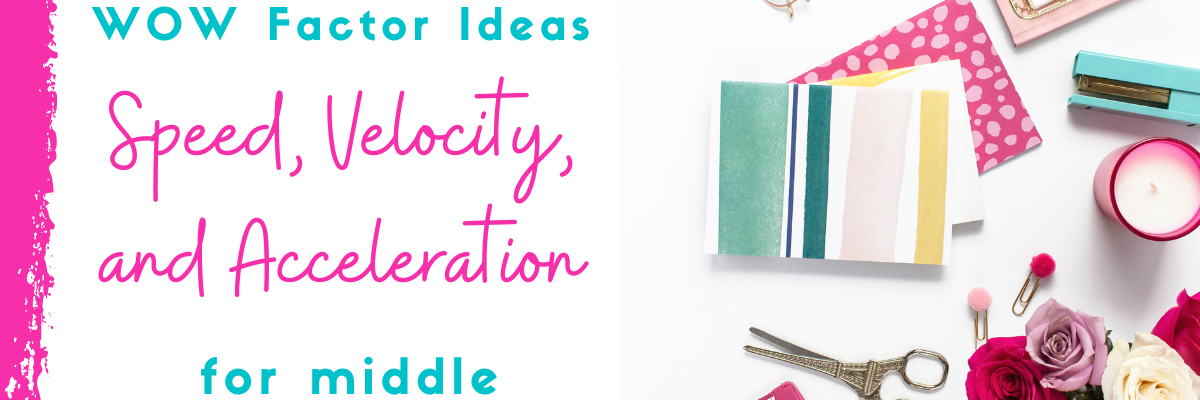Have you ever taught speed velocity and acceleration before? With the standards I have been required to teach, we taught about the atmosphere and weather, and then we moved on to forces and motion. The one thing about this order is that when students get to this unit, they are shocked and disappointed that they have to do so much math in science (like they were never related…. I know right?!).
Since it may take a little bit of effort to get students excited about this, I have some WOW Factor ideas that you can bring to your science classroom! First, I will share some ideas of how you can instill WONDER in your students regarding this topic. Then, I will share an interactive lesson that your students will love, and it will lead them through the content without allowing them to be overwhelmed. Finally, I will share some WIDEN activities to enhance their knowledge.
[Disclaimer: This post contains Amazon affiliate links. If you make a purchase through these links, I may earn a small commission at no extra cost to you.]

Speed, Velocity, and Acceleration WONDER Strategies
Well, since I try to keep things BRIGHT in the classroom, I make sure I work to instill WONDER and internal motivation into my students before diving into the science content.
Here are three ideas that you can use to help your students WONDER and want to learn about speed, velocity, and acceleration, and to be EXCITED to do the math!
Motion and Reference Point Activity
This is one of my favorite activities to do to start this unit off! Before learning about speed, velocity, and acceleration, students need to learn about what motion is and what a reference point is.
To do that, I would ask for a volunteer. Middle school students LOVE when they are involved.
Have that volunteer to do three tasks:
- Jump 3 times.
- Walk to the back of the room (or the front depending on where they are).
- Spin around.
At this point, both the volunteer and your other students will be wondering what in the world you just made the volunteer do!
Then, it’s time for a discussion!
Talk with your class:
- Was motion occurring?
- How could you tell?
- What were the reference points?
If they do not know the definition of motion and reference point, now is the time to discuss!
If your students love this activity, you can do it again for fun!

Create a Car – STEM Activity
If your pacing allows for several days to cover this topic, this is a great way to allow for your students to create an object that can be used for a later project…and I’ll get to that!
Let your students know that they are going to be designing a car. It can be whatever size they want it to be (maybe not too big…you can give them parameters); however, they do have to make sure that it has four wheels and that it rolls!
Later, they’ll be testing the speed and velocity of these cars at different initial heights!
If you plan ahead, you can have students, parents, and colleagues bring in materials for this project.
You can also make this in outside of class project!
Here are some examples of materials that your students can use to create their car:
- water bottles
- cardboard
- CDs
- bottle caps
- straws
- rubber bands
- paper plates
- cork
- Lego wheels
You and your students can get as creative as you want with this.
Remember, these cars can be used for a WIDEN activity…stay tuned!
Video Observation
If you don’t have the class time for some of these WONDER strategies, I have an idea that you can use that can still instill wonder in your students.
Here is a video that you can show your students.
They may think it’s a little childish, but don’t let them fool you…they secretly love it.
As they are watching the video, give them the task of writing down 10 observations.
After the video, here are some things you can do.
- Have your students share with a partner the observations that they wrote down.
- Have each pair of students pair with other pair and share their observations.
- As a class, have volunteers to share out some of their observations.
Share with them that they are going to be learning about speed, velocity, and acceleration, and they will see some of their observation interwoven into the lesson.
An Interactive Lesson for Speed, Velocity, and Acceleration
How are speed, velocity, and acceleration related? How can you calculate these things? Can speed and velocity be the same?
Now that your students are intrigued about the topic, it’s now time to dive in and answer these questions! I love interactive lessons because they allow for students to go through content in chunks so that they are not overwhelmed with all of the information at once and they are able to process it before moving on. This helps students to retain information in their long-term memory.
This particular speed, velocity, and acceleration lesson is no exception. Students go through and learn the information, whether as a class, individually, or in partners, and there are embedded activities that help students to practice what they just took in.

This lesson and activity covers motion and reference points, speed, finding distance and time, scalar and vector, velocity, acceleration, how to find speed, velocity, and acceleration, and speed, velocity, and acceleration examples.
The embedded activities include practice problems, answering questions in a text box, drag-and-drop, and more!
Your students will love it! You can find it in the shop or on TPT.
Speed, Velocity, and Acceleration Activities to Widen Student Knowledge
At this point, your students have learned a lot, but now, they may need more practice and also the be given the ability show off what they have learned and to widen their knowledge!
Speed, Velocity, and Acceleration Cut-and-Glue
One of my favorite activities to do with my students right after the lesson is this cut-and-glue. Yes, middle school students love to cut-and-glue too!
This allows students to get the extra practice they may need for solving for speed, velocity, and acceleration.
I like this because it’s not your average speed, velocity, and acceleration worksheet. This is a self-checking worksheet. After students solve the problem in the work box provided, they will immediately be able to see if their answer is on the answer sheet. If they don’t see it, they know that they have made a mistake and that they need to try again.
I love letting my students try this on their own for about 10-20 minutes, then allow them to work with a partner to determine hold-ups and mistakes. There are 12 speed, velocity, and acceleration problems in all.
This can also be found in the shop and on TPT.
Speed, Velocity, and Acceleration Lab – Toy Cars
Remember the car that students made (look under Create a Car – STEM Activity above)? This is their opportunity to use them! If students haven’t created a car for this activity, no worries, they can use a hot wheel or a similar toy car! Check out the lab!
For the simplest version of this activity, here are some directions for your students.
Big Question: What will happen to the speed of a toy car when the height of a ramp is increased?
Hypothesis: Have your students create a hypothesis for the big question. If I increase the height of the ramp, then…
Materials:
- 3 textbooks, STEM car or toy car, piece of paper or cardboard for ramp, meter stick or measuring tape
Procedures:
- Tape a piece of paper or cardboard ramp to the edge of one textbook.
- Let go of the car at the top of the ramp. Measure its distance and time of travel.
- Repeat twice, adding a book each time.
Students can record their information in a chart on a piece of paper or in their science notebooks.
Conclusion: Students need to write their conclusion.
New Question: What new questions do students have? If time allows, let them experiment to answer their new questions!
As with any activity, you can make this a simple or as complicated as you wish for your classroom and student needs.

Design a Ramp – STEM Activity
Ok, so this is a separate activity, but it’s also considered an extension activity for the toy car lab mentioned above. So, you know the ramp that they used in the last activity? Well, they can design their ramp! This just adds a little flavor to your lab activity, giving them more involvement in the creation of the experiment.
They just need to add design with markers, colored pencils, etc. You want the ramp to be flat.
While we are talking about decorating things. You can add some fun to your classroom when you complete a lab such this. There is a trend going around to decorate your room like a NASCAR race. O,h what fun!
Learn more about speed, velocity, and acceleration for middle school students!


[…] Speed, Velocity, and Acceleration […]